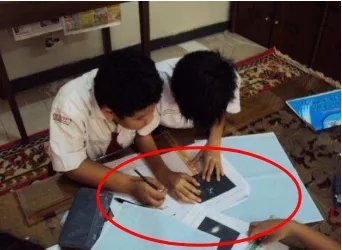236
STUDENT’S ABILITY TO CONSTRUCT MATHEMATICAL IDEAS IN THE
TOPIC OF COORDINATE CARTESIAN SYSTEM IN PRIMARY SCHOOL
Meldariani Roy1, Ratu Ilma Indra Putri2, Somakim3 Universitas Sriwijaya1,2, 3
meldariani.pcmtk2011@gmail.com1 , ratu.ilma@yahoo.com2 ,
somakim_math@yahoo.com3
Abstract
Design Research results are presented from a study in which student’s ability to
construct mathematical ideas. The concept of fundamental mathematical ideas in this study are used by students in finding formal mathematical form that depart from the context of science and cosmology through PMRI approach (Pendidikan Matematika Realistik Indonesia). HLT (Hypothetical Learning Trajectory) that are designed in 4 activities which contains a series of learning processes that will see the mathematical ideas that students used to solve any given problem. Based on the results of a pilot experiment, the mathematical ideas are used by students in constructing their own understanding of the context are approximation, geometric shape, locating, measuring, number / counting, and symbolization.
Keywords : Fundamental mathematical ideas, HLT (Hypothetical Learning Trajectory), science and cosmology context, PMRI.
INTRODUCTION
One of the challenges in education today is how to teach mathematics meaningful. It required reform in mathematics learning. Freudenthal (in Van den Heuvel-Panhuizen, 2001: 3) states that in the learning of mathematics must be connected to the real world, which is close to the children and relevant to the values of life. The challenge for a teacher are teacher expected to provide real-world situations and contexts for students to understand mathematical ideas and to provide an opportunity for them to identify and associate with the mathematical relationship of their lives. It means that teachers must be able to identify and understand the relationship, which is likely to require them to consider math and teaching math in new ways (Roy, 2013).
One solution to the above problems is to provide the proper context and modeling in any material. Grigoras (2010 : 2207) say that Modeling always involves mathematising, which is regarded as activity of observing, sructuring and interpreting the world by mens of mathematical models. The use of the model (the use of the models by vertical instruments) in the learning of mathematics is needed as a bridge of something that is concrete to the abstract (De lange, 1987).
To design a fun learning math teacher should be able to use a suitable context for children of primary school age as the context of science and cosmology. According with the characteristics of the proposed RME De Lange (1987) is The intertwining of various learning strands, which in this context learning integrated with other sciences such as science and cosmology. Through the implementation of RME in learning mathematics, students are able to construct their own mathematical ideas
237 which then represented a general formulation. According to the Treffers in Grigoras (2010: 2207), in educational context, the idea of two ways of mathematising, which led to reformulation by Freudenthal in terms of horizontal and vertical mathematisation. Mathematisation in realistic mathematics education itself meant as a process of improvement and development of mathematical ideas gradually, the so-called level-raising (Freudenthal in Wijaya, 2012: 42).
Schweiger (Schweiger (2006); Grigoras (2010) also summarize the main ideas of the mathematics of different sources including: algorithm, characterization, combining, designing, approximation, explaining, function, geometrization, infinity, invariance, linearization, locating, measuring, modeling, number /counting, optimality, playing, probability, shaping. Some basic ideas are expected to occur during the learning process takes place later. Research question in study is How the student’s ability to construct the mathematical ideas in the topic of coordinate cartesian system
in Primary School? . Based formulation of the problem, the purpose of this study is "Knowing the students' ability in constructing a the mathematical ideas in the topic of coordinate cartesian system .
This research are expected be useful for teachers in providing instructional design, to train students in understanding the learning process that has been practiced in class, for schools to provide information about students' learning ability and for researchers in the field of education in providing a reference for further research. This research is a design research, which is an appropriate way to answer the research questions to the research objectives.
MAIN SECTION
This study was designed to be 4 activities that will see students' mathematical ideas used in completing each activity. A series of these activities include:
(1) Activity 1, Watching Video and Exploring
In this activity students are given a variety of images in the context of science and cosmology. Students are guided to describe the location of an object (in this case the position of stars) to use their own language.
(2) Activity 2, Find the Way and Labelling!!
In this activity, students will be given a problem in the form of a story. Then the students should find solutions to these problems. students will learn to construct thought to explain where the location of a hidden planet by his friend.
238 In the first activity, students generally interpret images "Ancient White Dwarf Stars" and "Telescope Eyes a Loose Spiral Galaxy" by giving an explanation based on the explanation that they see in a video that display at the beginning of learning. However, some mathematical ideas arise in the description of the pictures, such as: students estimate (Approximation) the distance from the earth to the stars are very far away, the stars form like a circle and form of galaxies like vortex, students realized that the number of stars in the sky are very much (Approximation); the form of galaxy is bigger than another stars around it (Geometric shape); the location of the stars are very far away from the earth (locating, measuring); number of the stars are so numerous (number / counting).
.
Image source: http://www.nasa.gov/multimedia/imagegallery/iotd.html
Figure 1. Ancient White Dwarf Stars
Image source: http://www.nasa.gov/multimedia/imagegallery/iotd.html
Figure 2. Hubble Eyes a Loose Spiral Galaxy
In the beginning of activities in activity 2 students are given a problem in the form of a story, where students are required to solve the given problem. They give numeric symbols at each point of the representation of mathematical ideas. The second problem in this activity is that students should direct the plane to go to the stars that is intended by the students. One group give a detailed explanation and other groups only give explanations in outline only. To answer the second question is one group using the idea of give cardinal directions symbol to direct the pilot to the target planet.
239 Figure3. Students Doing Measurement Location of Stars
The first thing they did was measure the distance 1 of a horizontal line on the side of the image and then measure of vertical lines on the sides of the image, size obtained then transferred to graph paper. Then give a small circle as a representation of the planet (Geometry shape and approximation ideas) at the meeting point of the vertical and horizontal lines are drawn from the graph paper.
Figure4. Image results are made vedry and Ghandi
The first activity the students are playing Tebak Dimana Aku?? . Guess who successfully answered by the opponent will be written in the column answers that have been provided on the activity sheet. See Figure 5.
Figure 5. vedry and Gandhi’s Answers on Activity sheet 4
240 research showed that students generate more ideas in solving mathematical problems. At the beginning of learning, without them knowing that they have used the idea of representing mathematical objects as objects shaped like a circle. Until the students make the conclusion that they have used the Cartesian coordinate system in determining the position of a point. This indicates that they have been applying mathematics in their daily lives. Where it can then be explored further through a set of learning processes that are designed by teachers or researcher.
CONCLUSION
This research is in the beginning phases the design research. In constructing mathematical ideas in the Cartesian coordinate system topics, students begin with a simple mathematical idea of geometric shapes to represent the context. For then this concept will always be used by students in the learning process further. At each phases student learning using so many mathematical ideas in constructing mathematical knowledge on the topic Cartesian coordinate system being studied. Mathematical ideas used by students include, approximation, geometric shape, locating, measuring, number / counting, and symbolization. For the next phases of
Freudenthal, H. (2002). Revisiting Mathematics Education. Dordrect, New York, Boston, Moscow: Kluwer Academic Publisher.
Grigoras, Roxana. (2010). Modelling in Environments without Numbers - A case study. Proceedings of CERME 6, January28th-February1st. pp 2206-2215. Lyon France.
Van den Heuvel-Panhuizen, Marja. (2000). Mathematics Education in Netherlands: A Guided Tour. Freudenthal Institute Cd-rom for ICME9. Utrecht :Utrecht University.
Van den Heuvel-Panhuizen, Marja. (2001). Realistic Mathematics Education as Work in Progress. Proceeding of 2001 The Netherlands and Taiwan Conference on Mathematics Education. pp 1-43. Taiwan: Common Sense in Mathematics Education
Roy, Meldariani. (2013). Pembelajaran Matematika Menggunakan Konteks IPA/ Sains dengan Pendekatan PMRI (Pendidikan Matematika Realistik Indonesia) di Tingkat Sekolah Dasar. Prosiding Seminar Nasional Pendidikan 2013. pp 215-224.
Schweiger, F. (2006). A Fundamental Ideas. A Brige Between Mathemtics and Mathematical Education. In Maasz, J. And Schloeglmann, W. (Ed). New Mathematics Education Research and Practice. Sense Publiser.
This paper can be cited as Zulkardi(2013). Proceeding The First South East Asia Design/Development Research (SEA-DR) International

